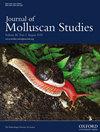珊瑚食性裸鳃鱼的新观察:形态、食性谱和早期发育
IF 1.2
4区 生物学
Q2 MARINE & FRESHWATER BIOLOGY
引用次数: 0
摘要
黑臂弯虫是一种广泛分布于热带太平洋的以珊瑚为食的裸鳃动物。先前的研究只揭示了黑尾蕨的两种颜色变种,一种是橙色的,捕食各种橙色的树蕨和管状蕨,另一种是深绿色的,捕食黑色的薇兰管状蕨和小管状蕨。这两种颜色的变种都生活在相对较深的水域(15-25米)。我们进行了形态学和分子分析,发现P. melanobrachia在浅水(<10 m)中以雌雄同体的硬核珊瑚Turbinaria peltata为食,呈米黄色形态。这三属珊瑚都属于树突珊瑚科,但树突珊瑚和Tubastraea是偶黄质珊瑚,而Turbinaria是虫黄质珊瑚。与它们的饮食一致,米黄色形态的甲壳尖端有大量的甲壳鞭毛细胞,而其他两种颜色形态的甲壳中只有很少或没有甲壳鞭毛细胞。我们对这种新的颜色形态的发现扩展了对这种珊瑚食性裸鳃动物的饮食、生态位和潜在生态影响的认识。本文章由计算机程序翻译,如有差异,请以英文原文为准。
New observations on the corallivorous nudibranch Phestilla melanobrachia: morphology, dietary spectrum and early development
Phestilla melanobrachia is a coral-eating nudibranch widely distributed in the tropical Pacific. Previous studies have revealed only two colour morphs of P. melanobrachia, an orange form preying on various orange Dendrophyllia and Tubastraea spp. and a dark green form preying on the black Tubastraea micrantha and Tubastraea diaphana. Both colour morphs live in relatively deep waters (15–25 m) of exposed shores. We conducted morphological and molecular analysis, which revealed a beige colour morph of P. melanobrachia that feeds on the hermatypic scleractinian coral Turbinaria peltata in shallow waters (<10 m). The three genera of corals all belong to the family Dendrophylliidae, but Dendrophyllia and Tubastraea are azooxanthellates whereas Turbinaria is zooxanthellate. Consistent with their diet, the beige colour morph has a high abundance of dinoflagellate cells in the ceratal tips, whereas the other two colour morphs contain only few or no dinoflagellate cells in their cerata. Our finding of this new colour morph extends the knowledge about the diet, ecological niche and potential ecological impact of this species of corallivorous nudibranch.
求助全文
通过发布文献求助,成功后即可免费获取论文全文。
去求助
来源期刊

Journal of Molluscan Studies
生物-动物学
CiteScore
3.00
自引率
8.30%
发文量
36
审稿时长
3 months
期刊介绍:
The Journal of Molluscan Studies accepts papers on all aspects of the study of molluscs. These include systematics, molecular genetics, palaeontology, ecology, evolution, and physiology. Where the topic is in a specialized field (e.g. parasitology, neurobiology, biochemistry, molecular biology), submissions will still be accepted as long as the mollusc is the principal focus of the study, and not incidental or simply a convenient experimental animal. Papers with a focus on fisheries biology, aquaculture, and control of molluscan pests will be accepted only if they include significant advances in molluscan biology. While systematic papers are encouraged, descriptions of single new taxa will only be considered if they include some ‘added value’, for example in the form of new information on anatomy or distribution, or if they are presented in the context of a systematic revision or phylogenetic analysis of the group.
 求助内容:
求助内容: 应助结果提醒方式:
应助结果提醒方式:


